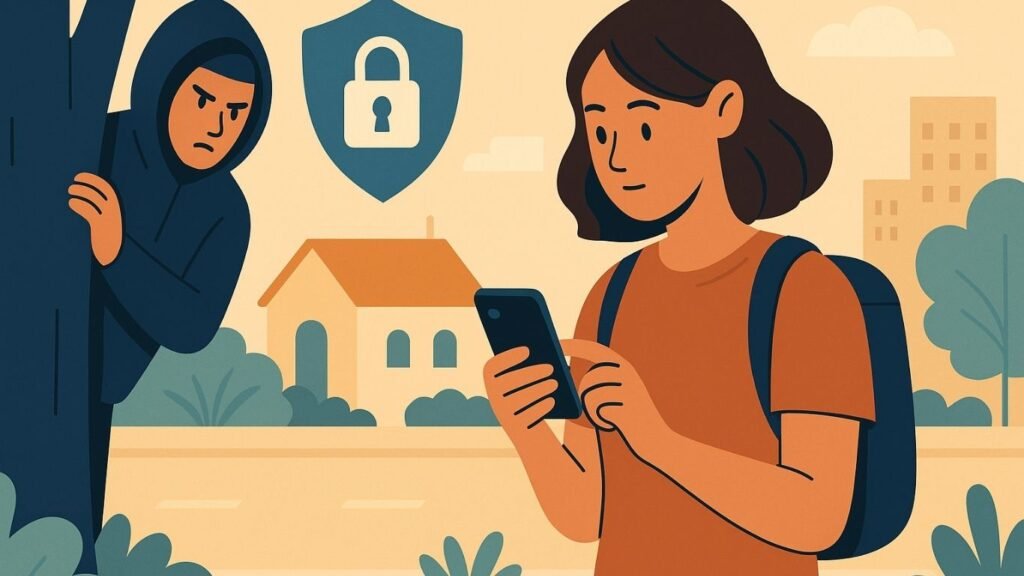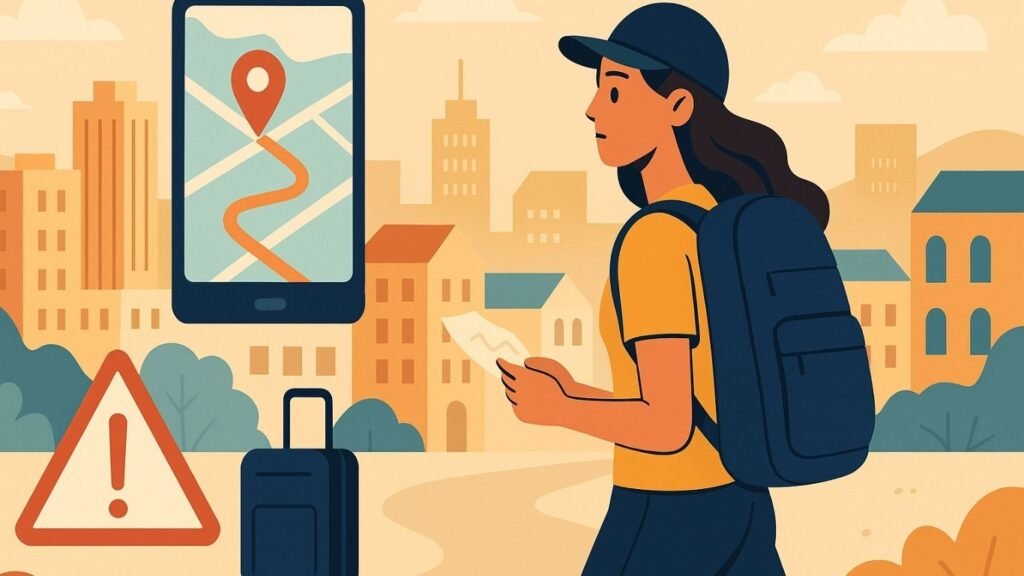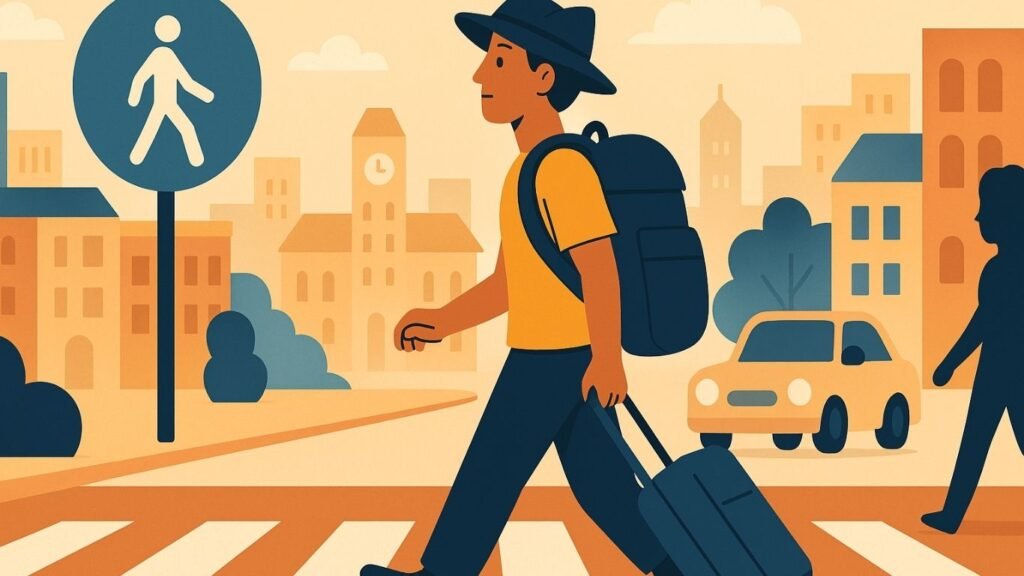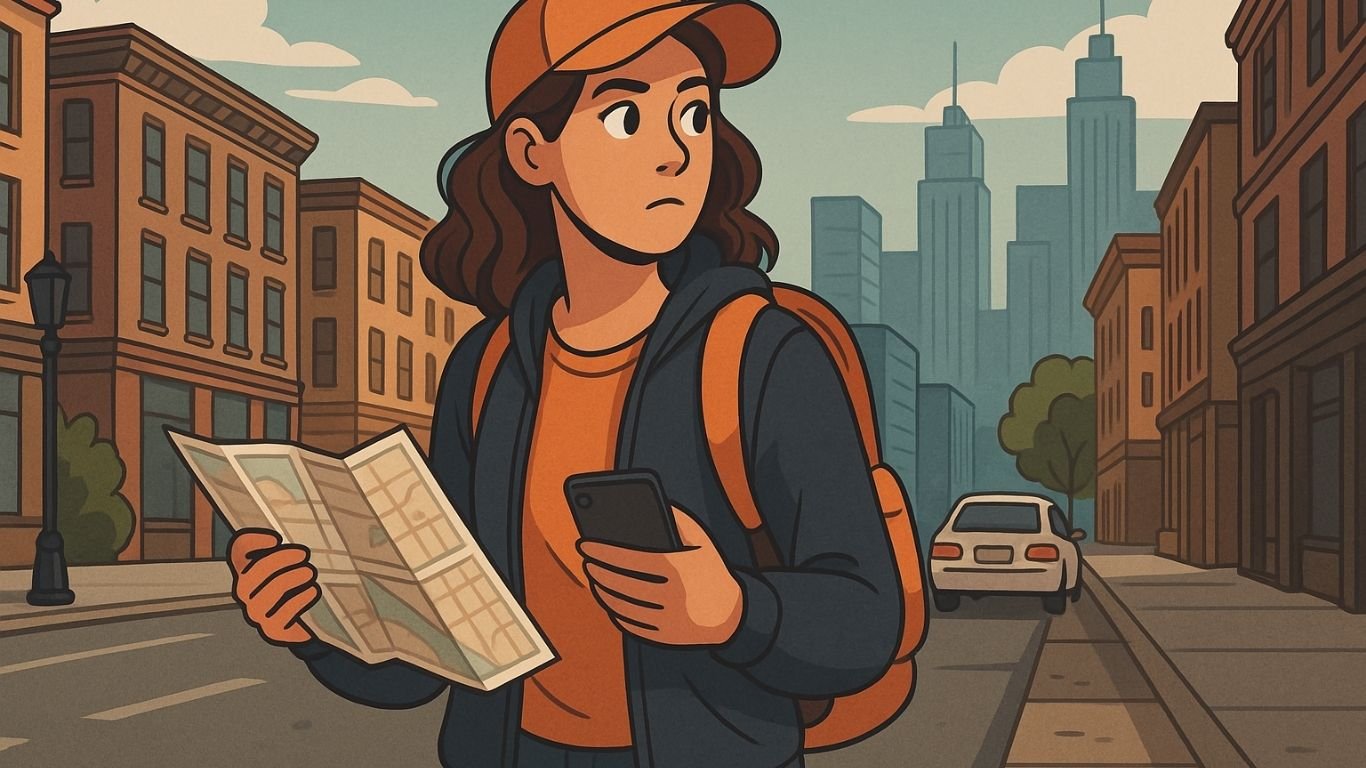There’s something magnetic about stepping into a city you’ve never seen before. The air carries a different rhythm, the streets hum with unfamiliar energy, and each corner hides a new story. But while exploring the unknown can be exhilarating, it also requires an extra dose of vigilance. Whether you’re traveling solo or with company, staying safe in unfamiliar cities should never be an afterthought—it should be a mindset.
In a world that thrives on spontaneity and adventure, safety planning can feel like a chore. But it’s the smartest way to enjoy your journey without unwanted surprises. From navigating foreign transport systems to understanding local customs, each city brings its own set of risks and rewards. That’s where this guide comes in.
This article presents 9 practical, street-smart strategies for staying safe in unfamiliar cities—drawn from expert insights, personal experiences, and real-world travel data. It’s not about being paranoid. It’s about being prepared. Whether you’re a first-time traveler or a seasoned explorer, these tips will empower you to experience new destinations with confidence and clarity.
Because when it comes to travel, freedom and safety should walk hand in hand. And when you’re street-smart, the new city you just landed in becomes less of a risk—and more of an unforgettable chapter in your journey.
Table of Contents
1. Plan Ahead, Travel Smart
One of the most powerful ways to ensure you’re staying safe in unfamiliar cities is by planning ahead. Preparation transforms uncertainty into confidence. It allows you to move through foreign streets not as a target, but as a traveler with a purpose.
1.1. Research Your Destination
Before you even book your ticket, dive into detailed research. Look into local laws, customs, safe neighborhoods, and areas known for crime. Sites like the U.S. State Department’s travel advisories or forums like TripAdvisor and Reddit can give you real-time insights. The more you know about a city, the easier it is to spot red flags—and avoid them. Staying safe in unfamiliar cities starts with knowing what to expect.
Check crime maps and local blogs to understand the rhythm of the city. Some neighborhoods that look picturesque during the day might change character at night. Knowledge is your first layer of protection.
1.2. Share Your Itinerary
While spontaneity is exciting, keeping someone informed of your whereabouts is just smart. Share your itinerary with a trusted friend or family member. Let them know where you’re staying, your flight details, and any planned excursions.
It may feel unnecessary, but if something goes wrong, knowing someone back home is aware of your movements can be a lifeline. It’s another pillar of staying safe in unfamiliar cities—you’re not entirely alone, even if you’re halfway across the world.
1.3. Secure Important Documents
Keep your passport, visa, insurance papers, and ID secure. Always have digital backups stored in the cloud, and keep photocopies in a separate bag. Losing documentation in a foreign place can be more than just inconvenient—it can become a safety issue.
Use RFID-blocking wallets and travel pouches worn under your clothes to minimize risk. In many situations, staying organized is staying safe—and again, it all ties back to the broader practice of staying safe in unfamiliar cities.

2. Blend In, Observe More
When it comes to staying safe in unfamiliar cities, visibility isn’t always your friend. The more you stand out as a tourist, the more you risk becoming a target. Blending in isn’t about suppressing your identity—it’s about harmonizing with your environment so you can move freely, respectfully, and safely.
2.1. Dress Appropriately
Fashion varies wildly around the world, but one rule remains constant: locals always notice outsiders. Dressing in a way that mirrors local customs isn’t just polite—it’s strategic. Modest attire in conservative regions or avoiding flashy accessories in economically strained areas can go a long way toward staying safe in unfamiliar cities.
Neutral colors, comfortable shoes, and practical bags make you less conspicuous. When in doubt, observe what locals wear and aim to match their general tone.
2.2. Pay Attention to Your Surroundings
The fastest route to trouble is distraction. Whether it’s a pickpocket at a crowded market or an unfamiliar alleyway that doesn’t feel right, situational awareness is your first line of defense. Staying safe in unfamiliar cities often means training your senses—stay off your phone in transit hubs, watch the people around you, and trust your instincts when something feels off.
Urban environments can be full of energy, but learning how to mentally filter out the noise and focus on potential threats helps you stay one step ahead.
2.3. Avoid Looking Like a Tourist
It’s tempting to pull out a paper map or snap a selfie in front of every landmark. But these habits can scream “outsider” louder than anything else. Discreetly check directions on your phone. Be subtle with cameras. Walk with purpose, even when you’re not entirely sure where you’re going.
By minimizing obvious tourist behaviors, you reduce your visibility to scammers, opportunists, and criminals—another crucial tactic for staying safe in unfamiliar cities.
3. Tech is Your Friend
In today’s digital age, technology isn’t just a convenience—it’s a vital tool for staying safe in unfamiliar cities. With the right digital resources, your smartphone can become a personal security hub, navigation assistant, emergency beacon, and more. Knowing how to leverage tech smartly can help you avoid unnecessary risks and navigate new terrain with confidence.
3.1. Utilize Offline Maps
Don’t wait until you’re lost to think about navigation. Download offline maps before you arrive in a new city. Google Maps, Maps.me, and CityMaps2Go are excellent apps that let you mark important spots like your hotel, embassies, and public transport stations.
Even without internet access, offline maps help you stay oriented and make safer decisions. It’s another smart layer in the larger strategy of staying safe in unfamiliar cities—especially when Wi-Fi is unreliable or mobile data is limited.
3.2. Download Helpful Safety Apps
There’s an entire ecosystem of mobile apps designed to help travelers stay safe. Apps like bSafe, GeoSure, and TripWhistle let you share your location, receive safety alerts, and even trigger SOS alarms if something goes wrong. GeoSure, for example, offers crowd-sourced safety scores for neighborhoods in real time.
Having these apps installed before your trip gives you peace of mind and instant support if you feel uneasy—further reinforcing your efforts toward staying safe in unfamiliar cities.
3.3. Keep Your Devices Charged
A dead phone is more than an inconvenience—it’s a safety hazard. Keep a compact power bank in your daypack and make a habit of charging your devices at every opportunity. Avoid draining your battery on social media or photo filters when you might need that power for navigation or emergency calls.
When tech is your lifeline, preparedness is essential. Keeping your device functional is an often-overlooked but vital component of staying safe in unfamiliar cities.

4. Trust Your Gut, Stay Alert
Instinct is one of your most powerful tools when it comes to staying safe in unfamiliar cities. While technology and planning are essential, nothing replaces that primal sense that something feels off. Tuning into your intuition, paired with situational awareness, can help you make quick, life-saving decisions when things get unpredictable.
4.1. Be Wary of Strangers
One of the joys of travel is meeting new people—but that doesn’t mean you should trust every stranger. Be friendly, but cautious. If someone approaches you too eagerly, asks overly personal questions, or tries to isolate you from public view, it’s okay to walk away.
Scammers and predators often rely on social pressure or false familiarity to lower your guard. Recognizing this tactic is key to staying safe in unfamiliar cities, especially in places where tourists are frequently targeted.
4.2. Avoid Risky Areas
Even in cities that are generally safe, there are pockets that become dangerous, especially after dark. Before venturing out, research neighborhoods with high crime rates and talk to hotel staff or locals about areas to avoid. Stick to well-lit, populated places whenever possible.
Walking down an unfamiliar street without knowing its reputation can make the difference between a pleasant stroll and a risky encounter. Making informed choices about where you go is fundamental to staying safe in unfamiliar cities.
4.3. Limit Nighttime Wandering
Some of the most serious travel incidents happen late at night. After-hours transportation becomes limited, streets quiet down, and shadows can become hiding places. If you must go out at night, stick to main roads, avoid shortcuts, and always have a plan to get home safely.
Whether you’re leaving a restaurant, attending a local event, or taking a nighttime walk, be deliberate. Don’t rely on luck or convenience—your approach to night travel should be intentional and cautious, with staying safe in unfamiliar cities always top of mind.
5. Practical Precautions
Sometimes, the simplest steps are the most effective when it comes to staying safe in unfamiliar cities. Small decisions—like how you carry your bag, what emergency numbers you know, or even a few words in the local language—can make a big difference in your travel experience. These aren’t flashy tips, but they’re the building blocks of travel safety that truly work.
5.1. Protect Your Belongings
Petty theft is one of the most common issues travelers face in unfamiliar cities. Use anti-theft backpacks with lockable zippers and cut-proof straps. Never carry all your valuables in one place, and always be mindful of your bag in crowded spaces like train stations, markets, or public transport.
A money belt, hidden pouch, or under-clothing wallet offers extra security. These tools might feel cumbersome at first, but they’re invaluable for staying safe in unfamiliar cities where pickpockets are active and opportunistic.
5.2. Know Local Emergency Numbers
Don’t assume 911 works everywhere. In fact, most countries have their own emergency hotline numbers. Look them up before you go and save them in both your phone and wallet. In a crisis, knowing how to call for help—without fumbling or Googling—can save precious seconds.
It’s a small but essential move toward staying safe in unfamiliar cities, especially if you’re traveling solo or exploring areas off the beaten path.
5.3. Learn Basic Local Phrases
Language barriers can become dangerous in emergencies. Learn key phrases like “Help,” “Call the police,” or “I need a doctor.” Even a basic grasp of greetings and directions shows respect and can ease communication in tense situations.
Apps like Duolingo or Google Translate can support you, but don’t rely on tech alone—memorize a few core expressions. It’s a surprisingly powerful tool for staying safe in unfamiliar cities, where communication can be your strongest or weakest link.
6. Stay Connected, Stay Informed
No matter how seasoned a traveler you are, staying safe in unfamiliar cities requires constant connection—to people, information, and your environment. Staying informed and reachable can turn a potentially risky situation into a manageable one. Connectivity isn’t just about convenience—it’s about control and security.
6.1. Purchase a Local SIM Card (Optional)
International roaming charges can be brutal—and relying solely on Wi-Fi can leave you vulnerable when you need connection the most. Buying a local SIM card can give you immediate, affordable access to maps, messaging apps, and local emergency services.
It’s a small investment with major returns, especially if you’re navigating without a guide. Staying connected is directly linked to staying safe in unfamiliar cities, as it gives you the power to respond quickly, reroute your plans, or get assistance when necessary.
6.2. Connect to Secure Wi-Fi
Public Wi-Fi can be a double-edged sword. It may offer free access, but often comes with serious security risks—especially in airports, cafés, or transportation hubs. If you must connect, avoid checking bank accounts or sharing sensitive information. Better yet, use a virtual private network (VPN) to encrypt your data.
Being digitally secure is a critical piece of staying safe in unfamiliar cities. Cybercrime can hit just as hard as physical theft, and travelers are often easy targets.
6.3. Follow Local News and Advice
Subscribe to local news channels, embassy alerts, or neighborhood groups on social media. These sources keep you informed of protests, transportation strikes, weather events, or criminal activity—sometimes before even your hotel staff hears about them.
Real-time updates help you avoid unexpected disruptions and unsafe areas. When you stay informed, you stay empowered—and that’s the key to staying safe in unfamiliar cities no matter where your travels take you.

7. Accommodation Awareness
Your accommodation is your sanctuary while traveling—but even safe-looking places can pose hidden risks. Choosing the right lodging and being aware of your surroundings inside and out is central to staying safe in unfamiliar cities. Where you sleep should feel secure, not stressful.
7.1. Choose Safe and Reputable Lodging
Start with research. Don’t just look at ratings—read recent reviews that mention neighborhood safety, security features, and staff reliability. Platforms like Booking.com, Airbnb, and Hostelworld often have filters or badges for “safe neighborhoods” or “secure properties.”
Look for accommodations with 24/7 front desk service, CCTV surveillance, and secure entry systems. Booking a place in a well-lit, populated area—not tucked into isolated back alleys—adds another layer of defense for staying safe in unfamiliar cities.
7.2. Be Mindful of Hotel Security
When you arrive, take a mental walkthrough. Note emergency exits. Test the locks on your room’s door and windows. Don’t automatically trust a “Do Not Disturb” sign to keep your room private. Use a portable door lock, a rubber door stopper, or a wedge alarm for extra peace of mind.
Be discreet about your room number. And never prop the door open or leave valuables unattended. These small but deliberate habits go a long way toward staying safe in unfamiliar cities, especially in hotels where high turnover means staff and guests change frequently.
7.3. Secure Your Belongings in Your Room
Never leave passports, electronics, or large amounts of cash in plain view. Use a room safe when available, or better yet, bring your own portable travel safe. Always lock up before you leave—even if it’s just for a few minutes to grab food or step into the lobby.
Remember, theft doesn’t only happen on the streets. Being smart about how you store your belongings is part of the bigger picture of staying safe in unfamiliar cities. It’s about creating a personal zone of trust, even in a temporary space.
8. Transportation Tactics
Getting from point A to point B in a new city might seem straightforward—until it’s not. Transportation is one of the most vulnerable areas when traveling, and mishandling it can quickly compromise your security. Having a transport strategy is essential to staying safe in unfamiliar cities, where routes, customs, and risks may differ dramatically from what you’re used to.
8.1. Use Reliable Transportation Options
Avoid flagging down unmarked taxis on the street, especially in countries where ride scams are common. Stick with official taxis, hotel-arranged transport, or trusted ride-hailing apps like Uber, Bolt, or Grab. These platforms offer driver verification, route tracking, and the ability to share your ride in real time with someone you trust.
Knowing your transport provider adds a predictable layer to your movements—an underrated but crucial aspect of staying safe in unfamiliar cities. You don’t want to wonder who’s driving you when the sun goes down or the street signs stop making sense.
8.2. Be Aware of Taxi Scams
Tourists are often seen as easy targets for fare inflation or “broken meter” tricks. Be cautious of drivers who refuse to turn on the meter or who take unusually long routes. Research typical fares beforehand, or ask your hotel what a fair price should be.
Consider this part of your defense plan for staying safe in unfamiliar cities: always agree on a price beforehand if meters aren’t used, and keep a small stash of local currency in lower denominations to avoid disputes over change.
8.3. Know Your Route
Never board a taxi, bus, or train without knowing roughly where you’re going. Use Google Maps, Maps.me, or local apps to track your location in real time. Mark your destination and stay alert—especially if you’re alone or it’s dark.
Even public transit can pose risks if you’re not aware of the stops, the timing, or how to exit safely. Planning your route not only keeps you from getting lost, it reinforces your strategy for staying safe in unfamiliar cities by ensuring you’re never traveling blindly.

9. Emergency Preparedness
No matter how well you plan, surprises can happen. Emergencies—whether minor or major—can quickly escalate if you’re not ready. That’s why proactive thinking is a cornerstone of staying safe in unfamiliar cities. The goal isn’t to expect disaster, but to have the confidence and tools to handle it if it comes your way.
9.1. Have a Backup Plan
If your phone dies, if your accommodation falls through, or if public transit halts unexpectedly—what’s your next move? Always prepare a Plan B. Carry a backup power bank. Know alternative routes to your lodging. Have printed copies of your important documents, and a list of local emergency numbers.
Staying safe in unfamiliar cities means having layers of contingency. When something doesn’t go as planned, you shouldn’t be paralyzed—you should be ready.
9.2. Know Where to Seek Help
Familiarize yourself with local hospitals, police stations, and your country’s nearest embassy or consulate. Save their addresses in your phone and in a small notebook you can carry. In an emergency, these places are your lifeline.
Many countries have dedicated tourist police—specially trained to assist travelers. Knowing where to go for trusted help is a key element of staying safe in unfamiliar cities. When you have options, you have power.
9.3. Stay Calm in Emergencies
In a moment of crisis, your best defense is calm. Panic clouds judgment and delays action. Focus on breathing, assessing the situation, and using your pre-prepared resources. Whether it’s a lost passport or a tense street encounter, your reaction defines the outcome.
Practice “mental rehearsals” before you go: What would you do if you lost your bag? Missed a bus at night? Felt followed? Running through these scenarios builds confidence, and confidence is essential to staying safe in unfamiliar cities.
Conclusion: Confidence Is the Ultimate Travel Companion
Traveling to a new city is a thrill like no other. It challenges your perspective, introduces you to fresh ideas, and enriches your sense of independence. But without a sense of safety, even the most exciting destination can turn overwhelming. That’s why staying safe in unfamiliar cities isn’t a checklist—it’s a mindset.
From blending in with the locals to staying digitally connected, each tactic you’ve read is a step toward empowered, confident travel. Safety doesn’t mean fear. It means freedom. The freedom to explore, to connect, to wander—and to return home with nothing but memories and stories worth telling.
So go ahead. Book that ticket. Take that detour. Say yes to the journey—but take your street-smarts with you. Because in the end, staying safe in unfamiliar cities is the bridge between risk and reward, between uncertainty and unforgettable experience.
FAQ: Staying Safe in Unfamiliar Cities
Q: What’s the most important first step for staying safe in unfamiliar cities?
A: Research. Understanding the cultural norms, local laws, and neighborhood safety profiles of a new city lays the foundation for a safe trip. The more informed you are before arrival, the more confident and secure you’ll feel once you’re on the ground.
Q: Are travel safety apps really helpful?
A: Absolutely. Apps like bSafe, GeoSure, and TripWhistle are specifically designed to help you stay connected and alert authorities quickly if needed. They’re easy to use and make a significant impact on staying safe in unfamiliar cities.
Q: What’s the best way to avoid looking like a tourist?
A: Walk with purpose, dress in a way that aligns with local norms, and avoid using large maps or speaking loudly in public spaces. Subtlety goes a long way in staying safe in unfamiliar cities by helping you blend into your surroundings.
Q: Is public transportation safe in unfamiliar places?
A: Often, yes—but it depends on the city and time of day. Research your options beforehand, stick to major routes, and avoid isolated stations late at night. Public transport is part of city life, and with awareness, it can be a safe and efficient option.
Q: Should I still explore unfamiliar neighborhoods?
A: Yes—but cautiously. Stick to daylight hours, check crime statistics beforehand, and let someone know where you’re going. Discovery is part of travel, and staying safe in unfamiliar cities doesn’t mean avoiding adventure—it means approaching it smartly.
